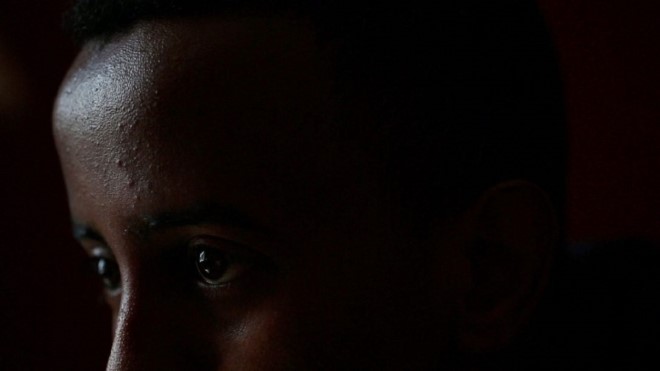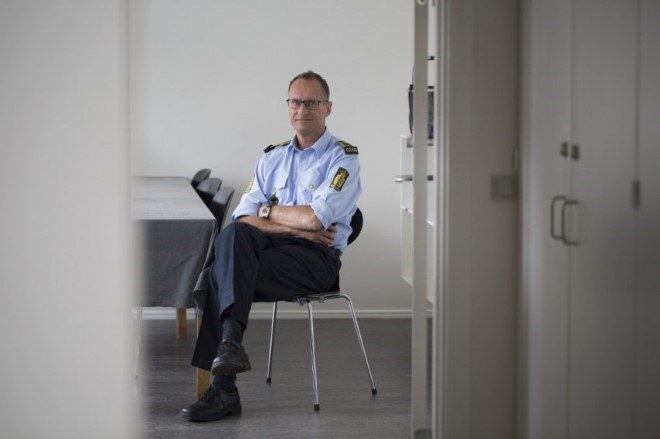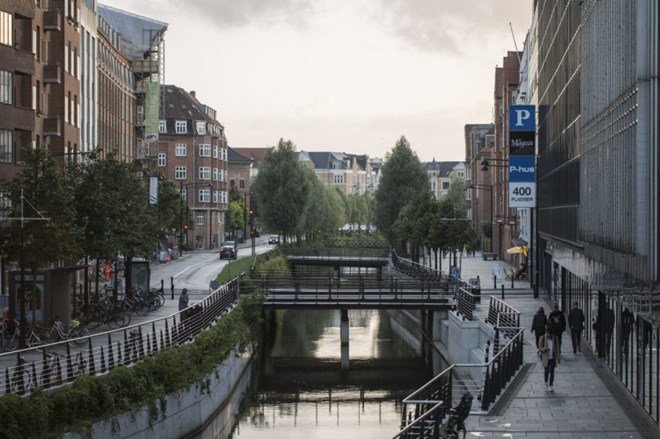
Sunday, August 21, 2016
By MICHELLE SHEPHARD
A trip to Aarhus, Denmark, reveals a nuanced, kinder, gentler approach to deradicalizing violent extremists, and it’s one that involves mentorship.

As a 20-year-old, Mohamed wanted to leave his home in Denmark to live in a Muslim country. While two of his friends left for Syria - and were killed - Mohamed entered a Counter Violent Radicalization mentorship program. Today, he's training to be a mentor himself. (RANDY RISLING / TORONTO STAR)
AARHUS, DENMARK — “Coffee?”
There’s a pot already brewing in the brightly lit, white-walled office. Three members of the East Jutland Police department sit around the table.
There is a weariness in the room; they have been here before explaining what they do to journalists, researchers, other police officers, community leaders, social workers, parents. The list goes on.
“A lot of this isn’t rocket science, I guess . . . .”
Supt. Allan Aarslev, the designated spokesman, cuts me off.
“I said that. This is not rocket science. It’s pretty basic. Why does the whole world come here?”
We come to this port city of 330,000, Denmark’s second largest after Copenhagen, because Aarhus tried something new in the well-trodden and well-funded field of CVE — countering violent extremism.
They were forced to do something when young people started disappearing and turning up in Syria. More than 30 left in 2013, which is a lot for a city this size. Instead of adopting the approach of most countries that enact new laws and throw people in jail, Aarhus started what is essentially a counselling program.
There are other countries over the years that have tried “rehabilitation” or “disengagement.” Saudi Arabia’s program is probably the best known and Somalia’s the most surprising.
But no western country, including Canada, started as early as they did here in Denmark.
This point was brought home hours after our meeting when a dramatic scene played out in Strathroy, Ont. Aaron Driver, a 24-year-old convert to Islam, reportedly detonated an explosive device in the back seat of a cab before he was shot dead by police. The RCMP stated he had made a “martyrdom” video threatening an imminent attack, which had caught the attention of the FBI, which alerted Canadian authorities.
Driver wasn’t a recluse, or a lone wolf who’s feared because he’s so hard to detect. He was very much on the radar of police and intelligence services. He had signed a peace bond. He talked with young extremists, journalists and academics. He and I exchanged texts, trying to set up a face-to-face interview that never materialized.
Had the video not been discovered, Driver could have killed more than just himself.
But relief this week has given way to questions: Why was he not monitored? Why did we need a tip from the Americans? Are peace bonds effective, or are they what Canadian lawyer Craig Forcese has called a “Goldilocks” problem — too weak for real terrorists but too strong for innocents who are wrongly labelled because of the low standard of proof?
Driver’s family has been searching for their own answers. In an emotional interview with the CBC, his older brother Rob concluded, “I think he was very damaged inside and we weren’t able to help him.”
Could someone have helped Aaron Driver? Many people tried.
But Driver lacked what Aarhus has been so good at developing — a formal mentorship program with contacts to get the individual help in all facets of their life.
Maybe that wouldn’t have worked for Driver either.
But there are others who fit his profile in Canada, to varying degrees, and his case does highlight the gap in our approach to CVE and how little action the Liberal government has taken in its first 11 months in power.

East Juntland Police Superintendent Allan Aarslev is the head of the Counter Violent Extremism program in Aarhus. (RANDY RISLING/TORONTO STAR)
Public Safety Minister Ralph Goodale reiterated the government’s goal to adopt a federal CVE program Monday. “Nationally, there is no overall cohesion or strategy,” he said, later stating that Ottawa is searching for “the antidote to this poison.”
There have been some attempts in Canada, but the efforts are disjointed. Montreal and Calgary stand out as leaders in this field, although both programs have downsides. The RCMP’s efforts have largely failed despite the effort of a few good people.
The federal police force should not waste any more time or money in formal CVE programs. The effort is always going to be regarded with suspicion. Playing soccer with Muslim youth following Friday prayers is not going to work when the Mounties’ job is to prosecute terrorists. Local police forces, which already have greater interaction with the community, are better equipped.
Likewise, a well-meaning attempt by the Canadian Council of Imams to enact “deradicalization clinics,” is not widely supported because Muslim communities object to programs led by religious leaders, since violent radicalization is not solely a religious problem.
There really is no “antidote” or a need for “clinics.”
As Aarhus Police Supt. Aarslev says, it is not rocket science.
It begins with a cup of coffee.
Mohamed got the call for coffee more than five years ago when the Middle East and North Africa began to erupt in protest, before the declaration of Daesh’s caliphate in Syria and Iraq.
Aarhus had already developed an outreach program to deal with right-wing extremists — “hooliganism” as it is often referred to here. But 20-year-old Mohamed was the first on the police radar as someone vulnerable to Al Qaeda or like-minded groups. He had yelled at a woman in his class because she was criticizing Islam. And not just yelled. He said that she should be “stoned” for her comments.
“I was a young kid, without any knowledge about how to debate properly, so I threw a lot of words against them. Some of them were shocked, you know,” Mohamed says.
His outburst started a chain of events when the students contacted the principal, who contacted the police.
“The police handled it like it was an imminent threat; we have to deal with this guy as soon as possible,” Mohamed says.
They went to his home and his father, a Somali immigrant who had come to Denmark to give his children a better life, was furious.
“He called me and said, ‘Come home right now,’ ” Mohamed says. “So I ran home and he yelled at me. ‘What did you do? The police came here? They want to know something about you and you don’t even want to tell me?’ And I say, ‘I don’t even know what is.’ ”
Mohamed went to the police station the next morning and was told he was under investigation. They searched his home as neighbours looked on; he was suspended and missed his exams.
By the time he was cleared, his life was in tatters. That same summer his mother died of a sudden heart attack, and Mohamed turned to his mosque for solace. There, he befriended a devout young man who eventually took him to his apartment and introduced him to his friends.
“There were Somalis and Arabs. Then he introduced me and said, ‘This is our brother, we’d like to welcome him. He has experienced something I didn’t want to wish for my worst enemy.’ I told them my story and they were in tears and warm and they welcomed me,” says Mohamed.
“It was like the brotherhood I never had in society.”
Mohamed spent most of his time with these new friends, watching videos, cooking together, becoming further estranged from his family.
Some in the community, and then the police, became concerned about the group.
When police called on Mohamed again, though, the circumstances were very different.
It may seem obvious, but for programs like this to work, the right people must be involved. Det.-Insp. Thorlief Link, who called Mohamed that day, is the right person. He doesn’t wear a uniform often, his manner is direct, but respectful and kind, and when he listens, he really seems to listen. Link is the police officer you would want to deliver bad news.
“He’s one of a kind. I’ve never met other cops who do the work the way he does,” Mohamed says.
But Mohamed’s admiration for Link did not come until years later. The first time Link called Mohamed he was furious. He had had enough police harassment. Why couldn’t they just leave him alone?
“I was like, ‘What do you want?’ He says, ‘I’m from police and I want to say sorry for how we handled your case.’ And I was like, ‘You’re sorry? You’re sorry about what happened to my case? I lost everything; you ruined my life.’ ”
But in his quiet, insistent way, Link persuaded Mohamed to come to the office for a coffee. He empathized. He listened. He assured Mohamed everything he was doing was voluntary and he wasn’t under investigation. Then he offered him a mentor, a civilian, and said he would step away.
What has made the “Aarhus model” successful is the light touch of police involvement, and intense participation of community mentors, who are from Muslim communities, but not religious leaders.
These mentors work one on one with returnees from Syria, or youths at risk in the community, helping with education, religious counselling, jobs or family problems.
It is about filling a void, whatever that void may be.
Essentially, it is about replacing the community that Daesh offers with a warm welcome.
Aarhus is a quaint city, with waterfront condominiums built to look like glaciers and an art gallery with a rooftop multicoloured panorama walkway, which hangs above the city like a circular rainbow. Patios lining the canals have twinkling lights and fleece blankets for the colder nights. Next year, Aarhus will be celebrated as the cultural capital of Europe and banners all over town are touting the distinction.

More than 30 young people left this port city of 330,000 for Syria, forcing the police department and municipality to devise a new Counter Violent Extremism program, which is known internationally as the 'Aarhus model.' (RANDY RISLING/TORONTO STAR)
Gellerupparken, about a 10-minute drive from downtown, is the city’s biggest “ghetto,” where the population tends to be immigrants and there is a lower income. But it looks nothing like France’s banlieues or other marginalized European communities. There have been tensions, but somehow Aarhus has not been afflicted by the anti-immigrant wave sweeping through Europe and other parts of Denmark.
Yasser works in a legal office not far from Gellerupparken. The 33-year-old came with his family from Turkey when he was just 2; they were only the second non-Danish family to settle in the small city where they lived outside Aarhus.
“I remember the first time I went into the classroom, one of the girls was standing up and was like, ‘What is this?’ in front of all the kids and teachers. It was the first time she had seen a person of different colour. I was 7 or 8 but I remember it very clearly,” Yasser says, laughing. “We have talked about it since because we saw each other at the 20-year reunion. She was embarrassed. She could also remember it.”
We have changed Yasser’s name and not included Mohamed’s last name at their request, to protect the anonymity of the mentorship program.
Yasser said he had been “headhunted” by a former police chief to work as a mentor when they met at an Iftar dinner during Ramadan.
Mohamed was his first mentee.
Their first meeting was tense. “He was like, ‘Why should I live here and what do you want from me?’ ” Yasser says. “I remember I also told him there was nothing wrong with being religious and in Islam there was nothing wrong with being a democrat.”
“Of course, there are people and politicians who always blame people of different origins for all their problems,” Yasser continued.
Yasser says at the beginning Mohamed saw him as a “traitor.” But his curiosity was piqued and he agreed to meet again and again. They shared meals. This continued for more than two years. “I used to go back to my group and get some advice in how to handle the debate with (Yasser),” Mohamed says. “But, in the end, I took my fists down.”
One day Yasser just seemed to make more sense than the young men from the mosque Mohamed had befriended.
During the months that Yasser pulled Mohamed back from the brink, three members of his group left for Syria. One is still there, his exact whereabouts unknown. Two others died.
Mohamed’s eyes get glassy when he thinks of his friends. “One of them told me that society was against him and he had a sister who was spit on just because she was wearing a scarf. He felt that he and his family weren’t safe in Denmark.”
“I was being mentored and recovering myself from the hatred, when that guy just went away,” he says. He feels bad he couldn’t help.
But Mohamed has become a mentor himself and is now helping others.
Statistics can be deceiving, especially when the numbers are small.
Most of the young people who left were killed. A few have returned and, if prosecution is not an option, which it often isn’t because authorities lack evidence of involvement with a terrorist group in many cases, they are offered this program.
It is voluntary, but a surprising number participate, first often out of curiosity.
Aarslev said he was shocked so many agreed to be paired with a mentor, but thinks it is the program’s reputation and people like Link who have made it a success.
They wince when their approach is described as “soft on terror” — hugging instead of handcuffs.
“This is not ‘soft’ methods or ‘hard’ methods. This is both. If these guys have committed crimes and we can prove they have committed crimes, they will be sent to jail and prosecuted,” Aarslev says. “However, in most of these cases it’s impossible . . . to prove if they have committed a crime. We would rather care for them than leave them alone because if left alone, the risk that they would commit crimes or even terrorist attacks here would rise.”
Only one person in the program is considered a failure, having left for Syria while he was offered counselling and help in the community. There are no other known cases.
The “returnees,” as they’re sometimes called, have by all accounts quietly resumed life with the help of the program. One is a new mother. Another just graduated from university. Both say they regret having gone to Syria and were shocked at what they found there.
It is hard now to envision Mohamed as that angry version of himself, the guy who shouted at a woman in his class. He is polite, thoughtful, a bit shy, although he welcomes me to Aarhus with a big hug.
It is the second time we have met. We also spoke in November at an international CVE conference in Denmark that attracted participants from around the world, including a police officer from Calgary.
There were former neo-Nazis on stage, academics, experts from all over Europe and the U.S., talking about CVE over three days inside an enormous candlelit auditorium, which had an unending buffet. Aarslev and Link were also at the conference, explaining what they do.
Although there are many other CVE programs, Aarslev says they won’t succeed unless there is sustained interaction with “the target group, telling them that we have a concern, trying to invite them into society.”
Their overall advice for other governments looking at CVE programs: “Less talk, more action.”
Another conference is scheduled to take place here next year.
About the series: The Atkinson Fellowship awards a seasoned Canadian journalist with the opportunity to pursue a yearlong investigation into a current policy issue. This award is a collaborative project of the Atkinson Foundation, the Honderich family and Toronto Star.
Michelle Shephard, the Star’s national security correspondent and author, travelled to a half-dozen countries and interviewed foreign fighters, security experts, policy-makers and religious leaders for this year’s series. Her stories about “Generation 9/11” will explore the issues of Daesh’s foreign fighters and how Canada and the world should respond. They will run periodically throughout the year.